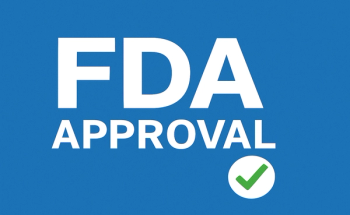
Study Summary: Denosumab Versus Risedronate in Glucocorticoid-Induced Osteoporosis
Background
Glucocorticoid use, the leading cause of secondary osteoporosis, is linked to an estimated 5% annual fracture rate. Glucocorticoid-induced osteoporosis increases patients’ risk of both vertebral and nonvertebral fractures. Although patients receiving long-term glucocorticoids benefit from fracture prevention strategies, treatment rates for glucocorticoid-induced osteoporosis are low.1
Therapies for osteoporosis work by reducing bone loss or increasing bone production. Drugs shown to be effective for glucocorticoid-induced osteoporosis include the bisphosphonates risedronate, alendronate, and zoledronic acid, which inhibit bone resorption, and teriparatide, which stimulates bone growth.1
Denosumab is a human monoclonal antibody that inhibits the action of receptor activator of nuclear factor kappa-B ligand, a protein that mediates bone resorption. Denosumab has been shown to increase bone density and reduce the risk of fractures in patients with postmenopausal osteoporosis. The effect of denosumab can be reversed by discontinuing the drug, making it potentially useful for patients for whom long-term bisphosphonate administration may pose a risk, such as those with renal impairment.1
Saag and colleagues compared denosumab with risedronate for the treatment of glucocorticoid-induced osteoporosis in patients who were receiving long-term glucocorticoid therapy. They chose risedronate as the comparator because risedronate data were available from previous studies and because risedronate was approved for use in all countries represented in their study. The total study period was 24 months. The publication summarized here presented the results of the 12-month primary analysis; the authors will report the 24-month efficacy and safety results in a separate publication.1
Study Design
This phase 3, multicenter, randomized, double-blind, double-dummy, active-controlled, noninferiority study was conducted at 79 facilities in 16 countries in Asia, Europe, Latin America, and North America. Participants were classified as glucocorticoid-continuing (receiving glucocorticoids for ≥3 months) or glucocorticoid-initiating (receiving glucocorticoids for <3 months). Participants included in the study were aged at least 18 years and were taking at least 7.5 mg of prednisone (or an equivalent glucocorticoid dose) daily. Patients younger than 50 years who were included in the study had experienced an osteoporosis-related fracture. Patients 50 years or older who were included in the glucocorticoid-continuing group had either (1) a bone mineral density T score of −2.0 or lower in the lumbar spine, femoral neck, or total hip, or (2) a T score of −1.0 or lower and a history of osteoporosis-related fracture. By design, men comprised no more than 40% of study participants.1
Patients were randomly assigned to 1 of 2 study groups: 60 mg subcutaneous denosumab every 6 months plus oral placebo daily (denosumab group), or subcutaneous placebo every 6 months plus 5 mg oral risedronate daily (risedronate group). Treatment continued for 24 months in both groups. Patients in both groups also took calcium (at least 1000 mg) and vitamin D (at least 800 IU) daily during the study.1
The researchers assessed participants at screening and at 10 days, 6 months, and 12 months after study initiation. They measured bone mineral density with dual-energy x-ray absorptiometry. To detect vertebral fractures, they obtained spine radiographs at 1 day and at 12 months after baseline and at other times as needed for clinical fractures. In some participants, the investigators measured serum levels of 2 markers of bone turnover, C-telopeptide (CTX) and N-terminal propeptide of type 1 procollagen (P1NP), at baseline, at day 10, and at 3, 4, 5, 6, and 12 months.1
The primary study outcome was noninferiority of denosumab to risedronate for change in lumbar spine bone mineral density from baseline to 12 months. Secondary outcomes were superiority of denosumab over risedronate for changes in lumbar spine and total hip bone mineral density at 12 months. The authors also reported 3 exploratory outcomes: change in femoral neck bone mineral density at 12 months, change in lumbar spine bone mineral density at 6 months, and serum bone turnover markers. The investigators assessed the outcomes involving bone mineral density separately in glucocorticoid-continuing and glucocorticoid-initiating patients. They assessed serum bone turnover markers in the total patient population.1
Results
Of the 795 patients initially enrolled, 691 (87%) completed the first 12 months of treatment (glucocorticoid-continuing patients: 217 received denosumab, 221 received risedronate; glucocorticoid-initiating patients: 122 received denosumab, 131 received risedronate). Baseline patient characteristics and treatment adherence were similar in the 2 treatment groups. The most common reasons patients dropped out of the study were withdrawal of consent and adverse events (AEs).1
Denosumab was noninferior to risedronate for the change in lumbar spine bone mineral density from baseline to 12 months in both patient subpopulations (glucocorticoid-continuing and glucocorticoid-initiating). The investigators determined noninferiority for this outcome by deriving noninferiority margins from the results of previous studies involving risedronate. The low ends of the 95% confidence intervals for denosumab in both subpopulations exceeded these thresholds, indicating that denosumab was not inferior to risedronate (
In the analysis of secondary and exploratory outcomes, denosumab was superior to risedronate for percentage changes in bone mineral density of the lumbar spine, total hip, and femoral neck from baseline to 12 months. Serum levels of bone turnover markers decreased significantly more with denosumab than with risedronate (at 12 months, P = .030 for CTX and P = .046 for P1NP).1
The AE rates were similar in the denosumab and risedronate groups. The overall incidence of reported AEs was 72% in the denosumab group and 69% in the risedronate group; of serious AEs, 16% occurred in the denosumab group and 17% in the risedronate group. Pneumonia, the most frequently reported serious AE, occurred in 1% of patients in the denosumab group and 2% of patients in the risedronate group. Infections were reported at similar rates in both groups: 27% of patients in the denosumab group and 29% in the risedronate group.1
One patient in the denosumab group experienced a femoral fracture. Osteoporosis-related fractures occurred at similar rates in both treatment groups (denosumab, 7%; risedronate, 6%), and other types of fractures occurred at similar rates in both groups (all ≤5%).1
Implications
The main study finding was that denosumab was noninferior to risedronate for increasing lumbar spine bone mineral density after 12 months in patients taking or beginning glucocorticoid treatment. Denosumab also was superior to risedronate for increasing lumbar and total hip bone mineral density at 12 months, and it was also associated with lower concentrations of bone turnover markers than was risedronate. The 2 drugs had similar safety profiles.1
Study strengths included the large sample size, the high patient completion rate, the active-comparator design, and the fact that the study population was generally representative of patients with conditions that require glucocorticoid treatment. Although the study did not have sufficient power to compare differences in fracture rates between the groups, change from baseline in lumbar spine bone mineral density is an accepted efficacy measurement in studies of osteoporosis. The authors noted that their results comparing denosumab with risedronate do not imply that denosumab is also superior to other drugs used to treat glucocorticoid-induced osteoporosis. They concluded that denosumab could be an effective treatment option for patients who are receiving or beginning glucocorticoid therapy and are therefore at risk of fracture.1
Reference
- Saag KG, Wagman RB, Geusens P, et al. Denosumab versus risedronate in glucocorticoid-induced osteoporosis: a multicentre, randomised, double-blind, active-controlled, double-dummy, non-inferiority study. Lancet Diabetes Endocrinol. 2018;6(6):445-454. doi: 10.1016/S2213-8587(18)30075-5.
Newsletter
Stay ahead of policy, cost, and value—subscribe to AJMC for expert insights at the intersection of clinical care and health economics.




























































